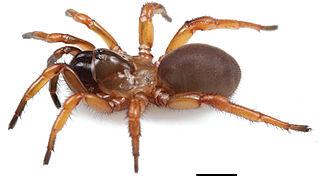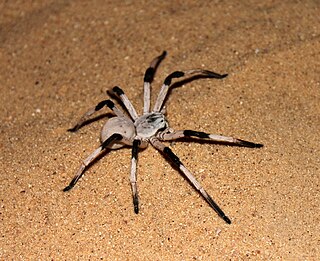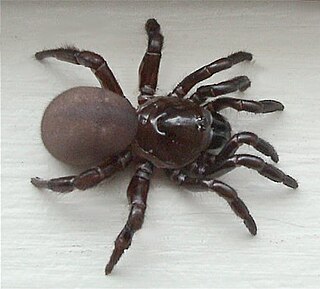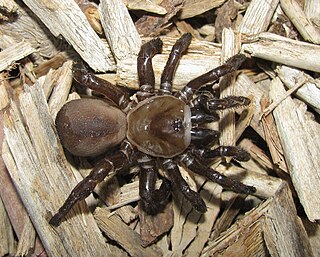
The spider family Liphistiidae, recognized by Tamerlan Thorell in 1869, when broadly circumscribed to include two subfamilies, comprises 8 genera and about 100 species of medium-sized spiders from Southeast Asia, China, and Japan. They are among the most basal living spiders, belonging to the suborder Mesothelae. In Japan, the Kimura spider is well known. In 2022, it was proposed to re-accept the subfamily Heptathelinae as the family Heptathelidae. As of December 2023, this proposal was accepted by the World Spider Catalog. In this circumscription, the family Liphistiidae has only one genus, Liphistius.

Ctenizidae is a small family of mygalomorph spiders that construct burrows with a cork-like trapdoor made of soil, vegetation, and silk. They may be called trapdoor spiders, as are other, similar species, such as those of the families Liphistiidae, Barychelidae, and Cyrtaucheniidae, and some species in the Idiopidae and Nemesiidae. The name comes from the distinctive behavior of the spiders to construct trapdoors, and ambush prey from beneath them.

Utricularia, commonly and collectively called the bladderworts, is a genus of carnivorous plants consisting of approximately 233 species. They occur in fresh water and wet soil as terrestrial or aquatic species across every continent except Antarctica. Utricularia are cultivated for their flowers, which are often compared with those of snapdragons and orchids, especially amongst carnivorous plant enthusiasts.

A trapdoor is a sliding or hinged door that is flush with the surface of a floor, ceiling, or roof. It is traditionally small in size. It was invented to facilitate the hoisting of grain up through mills, however, its list of uses has grown over time. The trapdoor has played a pivotal function in the operation of the gallows, cargo ships, trains, booby traps, and more recently theatre and films.

Barychelidae, also known as brushed trapdoor spiders, is a spider family with about 300 species in 39 genera.

Migidae, also known as tree trapdoor spiders, is a family of spiders with about 100 species in eleven genera. They are small to large spiders with little to no hair and build burrows with a trapdoor. Some species live in tree fern stems. They have a Gondwanan distribution, found almost exclusively on the Southern Hemisphere, occurring in South America, Africa, Madagascar, Australia, New Zealand and New Caledonia.

Cteniza sauvagesi is a trapdoor spider first described in 1788 by Pietro Rossi. These spiders have only been found in the Mediterranean region, mainly on the large islands of Corsica and Sardinia on roadside banks and in the littoral zone. They are darkly colored with a shiny head and can reach 20 millimetres (0.79 in) in length.

Ambush predators or sit-and-wait predators are carnivorous animals that capture their prey via stealth, luring or by strategies utilizing an element of surprise. Unlike pursuit predators, who chase to capture prey using sheer speed or endurance, ambush predators avoid fatigue by staying in concealment, waiting patiently for the prey to get near, before launching a sudden overwhelming attack that quickly incapacitates and captures the prey.
The Torreya trap-door spider is a species of spider in the family Halonoproctidae. It is endemic to the United States, and hitherto only known from along the Apalachicola River in Florida.

Stanwellia is a genus of South Pacific mygalomorph spiders in the family Pycnothelidae. It was first described by W. J. Rainbow & R. H. Pulleine in 1918. Originally placed with the curtain-web spiders, it was transferred to the funnel-web trapdoor spiders in 1985, then to the Pycnothelidae in 2020. It is a senior synonym of Aparua.

Myrmekiaphila is a genus of North American mygalomorph trapdoor spiders in the family Euctenizidae, and was first described by G. F. Atkinson in 1886. All described species are endemic to the southeastern United States.

Carnivorous plants are plants that derive some or most of their nutrients from trapping and consuming animals or protozoans, typically insects and other arthropods, and occasionally small mammals and birds. They still generate all of their energy from photosynthesis. They have adapted to grow in places where the soil is thin or poor in nutrients, especially nitrogen, such as acidic bogs. They can be found on all continents except Antarctica, as well as many Pacific islands. In 1875, Charles Darwin published Insectivorous Plants, the first treatise to recognize the significance of carnivory in plants, describing years of painstaking research.

Cerbalus aravaensis is a huntsman spider found in the southern Arava Valley of Israel and Jordan. The species was first described by Gershom Levy of the Hebrew University of Jerusalem in 2007, though news agencies later reported it in 2010 as a new discovery by a team of biologists from the University of Haifa. The spider has a leg span of 14 centimetres (5.5 in), making it the largest member of the family Sparassidae in the Middle East. Males have a body length of 1.85–2.40 centimetres (0.73–0.94 in), while females' body length is 2.20–2.65 centimetres (0.87–1.04 in).

Ummidia is a genus of mygalomorph spiders in the family Halonoproctidae, and was first described by Tamerlan Thorell in 1875.
Ummidia algarve is a spider species found in Portugal. Unlike other known Ummidia species, it creates a trapdoor at the entrance of the burrow.
Ummidia picea is a spider species found in Spain.
John Traherne Moggridge was a British botanist, entomologist, and arachnologist. A Fellow of the Linnean Society of London, he was known as a keen naturalist with great observational skills, as well as his paintings and illustrations. He wrote several articles on the fertilisation of plants, and his paintings of plants of southern France appeared in Contributions to the Flora of Mentone. His two volume study, Harvesting Ants and Trap-door Spiders, among other observations, confirmed that harvester ants are present in Europe, and was one of the first comprehensive treatments of the burrowing behaviour of trapdoor spiders. He was a correspondent of Charles Darwin, who cited his work in his books Fertilisation of Orchids and The Descent of Man, and Selection in Relation to Sex.

Halonoproctidae is a family of mygalomorph spiders, split off from the family Ctenizidae in 2018. Species in the family are widely distributed in North and Central America, Australasia, Asia, southern Europe and North Africa. One species is recorded from Venezuela in South America. They are relatively large, sombrely coloured spiders, that live in burrows with some kind of trapdoor.
Ummidia richmond is a species of spider in the family Halonoproctidae. It is endemic to Florida.












